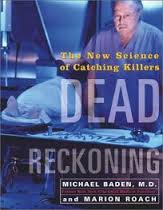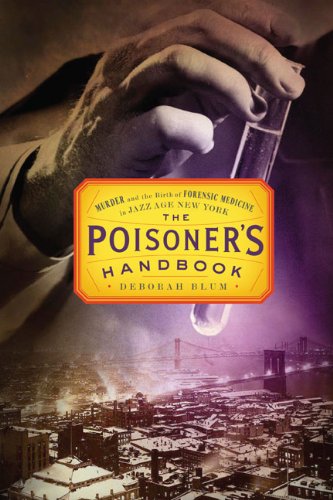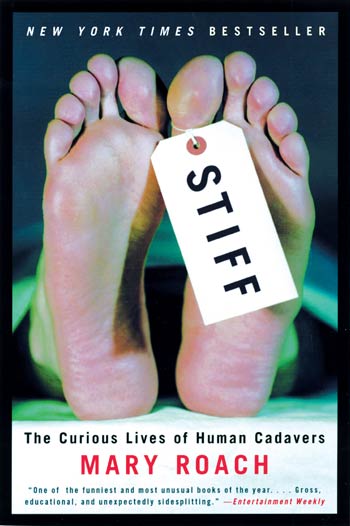 Dead Reckoning: The New Science of Catching Killers
Dead Reckoning: The New Science of Catching Killers by Michael Baden and Marion Roach
Simon & Schuster (August 2002)
Blood spatter, witnesses, exhumations, and incompetent forensic pathologists this book takes us deep into the world of forensic science, where an accurate reading of blood spatter can mean the difference between guilt and innocence. Baden (Unnatural Death: Confessions of a Medical Examiner), former New York City medical examiner and current codirector of the New York State Police Medicolegal Investigation Unit, takes on these topics plus some not commonly discussed: blow flies, autoeroticism, and the one aspect of his work that is "scary and unsettling even terrifying." One feels part of the autopsy team as Baden who has performed more than 20,000 such procedures describes how the body arrives (bagged and tagged) at the morgue, how the autopsy is performed, how to know the difference between cause and manner of death, and how a body is read by police and medical examiners for evidence. This book is more than the cases Baden handled; it is an in-depth, engrossing look, even for the squeamish, at how medical examiners work and why you want a competent one on your side.
Fingerprints: The Origins of Crime Detection and the Murder Case That Launched Forensic Science
by Colin Beavan
Hyperion (May 2002)
Beavan presents a lively focus on turn-of-the-20th-century politics and science as reflected in advances in law enforcement and criminal detection. The scientific backdrop for this slice of social history leading to the adoption of fingerprints as a forensic tool is carefully articulated within a narrative rich in the texture of locales and competitive ambitions. The author captures the role of key personalities, and the conflicts among them, as he deftly re-creates the pivotal 1905 murder case in Deptford, England, which served as a vehicle for the introduction of fingerprints as evidence in a jury trial. His research reveals how social hierarchies of the day and overlapping contributions to the field resulted in innovative work being erroneously credited. Groundwork laid by William Herschel in India; by Edward Henry and his colleague Azizul Haque; by Henry Faulds, a Scottish medical missionary in Japan; and by Francis Galton, of a prominent British family, is chronicled. The decades-long acrimony between Faulds and Galton is dramatically sketched. In counterpoint, Beavan takes care to describe the alternative methodology being simultaneously developed and implemented in France. Each of these efforts is skillfully outlined against the backdrop of law enforcement's dire need for a means of reliable identification of criminals.
The Poisoner's Handbook: Murder and the Birth of Forensic Medicine in Jazz Age New York
by Deborah Blum
Penguin Press (February 2010)
Pulitzer Prize-winning journalist Blum has cleverly packaged her account of the birth of forensic medicine by addressing the use and detection of various poisons in the early 20th century. The setting is the Prohibition era, when the death toll rose with the widespread distribution of bootleg liquor containing lethal methyl alcohol and the addition of poisons deliberately added by federal government regulation to make alcohols undrinkable. Blum focuses on New York City's first chief medical examiner, Charles Norris, and his colleague, longtime chief toxicologist Alexander Gettler. Norris was relentless in his advocacy for the new profession, often railing against government policies (or the lack thereof) that allowed unregulated poisons to be blithely used in industrial products, cosmetics, and medicinals despite injuries and deaths. Gettler was the consummate workaholic professional, meticulously testing and developing new techniques for extracting the remnants of poisons in corpses. Blum interlaces true-crime stories with the history of forensic medicine and the chemistry of various poisons. This readable and enjoyable book should appeal to history buffs interested in medicine, New York City, or the early 20th century generally. And of course scientists and true-crime aficionados will also enjoy it.
Stiff: The Curious Lives of Human Cadavers
by Mary Roach
W. W. Norton & Company (May 2004)
Those curious or brave enough to find out what really happens to a body that is donated to the scientific community can do so with this book. Dissection in medical anatomy classes is about the least bizarre of the purposes that science has devised. Mostly dealing with such contemporary uses such as stand-ins for crash-test dummies, Roach also pulls together considerable historical and background information. Bodies are divided into types, including "beating-heart" cadavers for organ transplants, and individual parts-leg and foot segments, for example, are used to test footwear for the effects of exploding land mines. Just as the nonemotional, fact-by-fact descriptions may be getting to be a bit too much, Roach swings into macabre humor. In some cases, it is needed to restore perspective or aid in understanding both what the procedures are accomplishing and what it is hoped will be learned. In all cases, the comic relief welcomes readers back to the world of the living. For those who are interested in the fields of medicine or forensics and are aware of some of the procedures, this book makes excellent reading.





2 comments:
What a great post! I actually saw Michael Baden speak at a seminar about forensics a long time ago, and it was fascinating. I also really loved Stiff and need to read it again! Love the mini reviews!
Great readings... real diversification.
Post a Comment